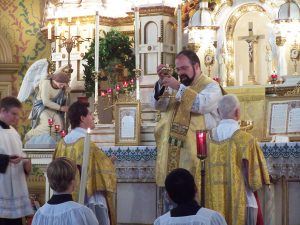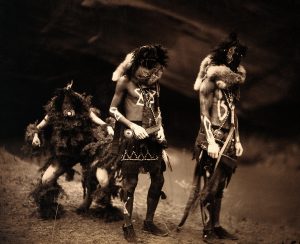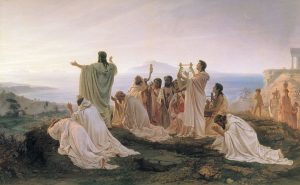The following is a talk presented at the Weatherhead Center for International Affairs, Harvard University, and is the second installment of a two-part series. The first installment can be found here.
II. Epistemological Musings
So much for “the deductions from the obvious” that I promised to explore with you. I also promised you some “epistemological musings,” and for these, I want to take things in a different direction.
Though anthropological ethnography’s hard-won reflexivity rescues it from Stark’s epithet on one level, there is another level that remains untouched. Rephrased a bit, the charge of “slow journalism” asks ethnographers to reflect on their particularism. Can the detailed study of a single society, a single village, even a single person produce generalizable knowledge? Or can it, at best, accumulate the facts, which, when added to the facts of thousands of other studies, produce such generalizations?
Think for a moment of how ethnography and other qualitative research methods are often portrayed, particularly in methods textbooks. Compared to quantitative methods, they usually play one of two roles. Either they are seen as preliminary investigations, the first forays into previously uncharted territory to be followed by large-scale mapping expeditions. Or they are case studies, which show how general social laws operate in a specific time and place.
Thus, Lynn Davidman’s Tradition in a Rootless World tries to figure out why some Jewish women convert to Orthodoxy, breaking ground for quantitatively-oriented sociologists to produce surveys that can tell us how widespread such phenomena really are.[1]
Or Shoshanah Feher’s Passing Over Easter tells us how well-understood social processes operate among Messianic Jews.[2] The latter of these is clearly sociologically informed journalism: it tells a story about a little-understood group, but it does not generate new theoretical knowledge. The former tells us something about religion’s shape, forcing us to revise our existing theoretical constructs or create new ones.
My first epistemological point has to do with the relative conceptual naiveté of much sociology of religion, including much that passes for theoretical work. As Peter Beyer points out in a brilliant article in the latest issue of the Journal for the Scientific Study of Religion, “the modern sense of what counts as religion and as a religion is a product of relatively recent, highly selective, and somewhat arbitrary historical (re)construction.”[3]
Beginning in the European “long reformations,” religion became defined as a matter of authorized belief wrapped in a particular organizational structure. Competing churches drew increasingly firm boundaries between “religion” and “superstition.” Popular beliefs and practices most often got edited out, producing a split between what Meredith McGuire calls “official” and “unofficial” religion.[4]
In part responding to official religion’s cultural hegemony, especially in North America,[5] sociologists of religion have largely failed to question what amounts to a definition of religion as “belief-cult.” (As Beyer points out elsewhere, this is the literal translation for the term that Chinese scholars use for religion, zongjiao. Having no indigenous term for religion, they found this the closest match to what they observed of Western religious practices. The occasional efforts to reshape Confucianism on a Western model failed, so the oft-repeated claim that the Chinese have no religion is true – but by definition.[6])
Knowing this, observing the historical construction of “Hinduism” as a “world religion” at the end of the 19th century, and seeing the ambiguous mix of official and unofficial religious elements in religious life as it is lived today, no reflexive ethnographer can accept the blithe assumption that national and trans-national statistics on religious belief and practice have the meanings claimed for them.
 “Cross-country data sets,” society-wide promotion of religious “values and behaviors,” and questions about religiosity’s decline arise from such arbitrary definitional acts that accurate generalization is scarcely possible. More precisely: generalizations based on such matters are as relative to their definitional axioms as Riemannian or Lobachevskian geometry are to their axioms about parallel lines.
“Cross-country data sets,” society-wide promotion of religious “values and behaviors,” and questions about religiosity’s decline arise from such arbitrary definitional acts that accurate generalization is scarcely possible. More precisely: generalizations based on such matters are as relative to their definitional axioms as Riemannian or Lobachevskian geometry are to their axioms about parallel lines.
Before I lower the boom any more on this, let me take an example from my social activist study. As part of that study, I have spent a good deal of time at the Los Angeles Catholic Worker. Not only does this give my students a chance to see the worst poverty in L.A., and on the street level, not in some tour bus; it also gives them a chance to experience an activist community that claims to “live its faith” – following Jesus to live among the poorest of the poor.
The community runs a soup kitchen, a free clinic, and an AIDS hospice, and there are always homeless folk present as long-term house guests. “Feed the hungry, clothe the naked, shelter the homeless” is more than a series of honored but otherwise ignored commandments. So, by the way, is “sit-in at the Federal Building, protest at Vandenburg Air Base, picket the Archbishop’s cathedral.” Catholic Workers do not make themselves popular with either worldly or churchly authorities.
Dorothy Day, by the way, was similarly difficult, but she always said that she’d close down her operation the moment the archbishop asked her to. The Los Angeles group says that they’ll be glad to talk with the archbishop about closing, over dinner at their favorite Mexican restaurant – and he should bring his credit card.
How do these people maintain their faith and their community, in the face of overwhelming opposition to their goals and the ongoing repressive direction of American public life? (Saint Dorothy also famously said, “Our chief problem is this stinking, filthy, rotten System,” a sentiment that her present followers affirm.) How do they keep going, when they acknowledge their complete political ineffectiveness, even at protecting the homeless from police sweeps?
Part of the answer is their insight that they must do this work, effective or not, because, to quote one of their leaders, “we will die [spiritually] if we do not practice what we believe.”[7] To use an old language, it saves their souls – not in some future world but here, right now. Their social activism is thus profoundly religious, even sacramental.
Another part of the answer, though, comes from their ritual life, specifically their Wednesday evening masses, held at their house in Boyle Heights, East L.A. Together with “family” and friends, often led by whichever priest they sprung from jail after their Wednesday morning protests – and when not, by a member of their own community – these celebrations help renew their sense of the rightness of what they are doing and of the appropriateness of the identity that they have chosen. Specifically, the experience of this ritual restores a polythetic sense of “rightness” to their world. By structuring time and attention, the house-mass restores their sense of their mission’s sacred character.
A dozen years ago, I described how Navajo ceremonies structure time and attention to create a restored experience of wholeness to their participants.[8] Catholic Worker masses similarly resemble and alter traditional Catholic ceremonies in such a way as to recreate a sense of experienced community.
I have described this at length elsewhere[9]; here I have time only to note that the ceremony begins with a depressing litany of the things going wrong with the world, moves to a communal homily, to which the entire group can contribute, halts for a passing-of-the-peace during which every participant hugs every other person in the room (which takes some time), and ends with a self-administered sharing of bread and wine.
 Symbolically speaking, the service moves participants from their wounded isolation into community, and then makes that community its own priest. Great buckets of soup are then blessed and served to those present. Eight to ten workers load the remaining soup and bread into a van, which they take to L.A.’s Skid Row and distribute to the homeless. Having made themselves priests in their own house, they serve as priests to the poorest of the poor, distributing the soup, bread, and water that are the ritual staff of life.
Symbolically speaking, the service moves participants from their wounded isolation into community, and then makes that community its own priest. Great buckets of soup are then blessed and served to those present. Eight to ten workers load the remaining soup and bread into a van, which they take to L.A.’s Skid Row and distribute to the homeless. Having made themselves priests in their own house, they serve as priests to the poorest of the poor, distributing the soup, bread, and water that are the ritual staff of life.
Like Navajo ceremonies, this ritual operates on at least three levels. The first level is thought, as the words of song, homily, and greeting reinforce worker theology. The second level is symbol, as I have just described: the transubstantiation not just of bread and wine and soup but of individuals into a priestly community.
The third level is experience, for this transformation does not just occur in head-space, to use a contemporary idiom. It also occurs through the structuring of time and attention, through the sequence of events that guide participants’ senses. Catholic doctrine claims that transubstantiation is more than symbolic, and Catholic Worker ritual practices the experiential transubstantiation of the community into the Body of Christ. (For the theorists among you, I use both Schutzian phenomenology and Navajo theology to trace such details in my full treatments.)
I previously suggested that the “what heroes!” response to my project comes from a contrast between liberal/leftists’ spiritual uncertainty and their projection of certainty onto the religious social activists whom I am studying. Let me now amend that suggestion – without any demonstration – by noting the cultural importance of the “quest for community” to precisely those social strata.[10]
Are Catholic Workers seeking community as much as they are seeking peace and justice, given that all three of these are counter-cultural in today’s America? What is the interaction between community and mission in the self-proclaimed peace-and-justice activist community? Is part of the “what heroes!” response a response to an imagined community, paralleling the imagined certainty I previously mentioned? Again, I cannot answer these questions, but they must be posed.
Back to my epistemological point. I have claimed that theoretical generalizations are accurate only relative to their definitional axioms: define religion as church plus belief and one can make one set of generalizations, define it differently and different generalizations present themselves. My reliance on Schutz and the Navajo grounds religion in experience rather than in discursive thought. Each set of theories generates a different religious object to investigate.[11] Epistemologically, these seem all on a level; you pay your money and you take your choice.

This is where ethnography becomes important in the study of religion. As a reflexive practice, ethnographic investigation involves the constant questioning of one’s own conceptual apparatus. Like journalists, pew counters, and survey researchers, ethnographers inevitably bring unexamined concepts into the field, through which they view their research site and subjects.
Unlike journalists, however, reflexive ethnographers are professionally committed to examining these concepts, to making them problematic. More, their conclusions (always tentative) arise from the spaces between concepts: from the interplay between the natives’ visions, the visions that they brought with them to the field, and their ever-transforming understanding of the multitudinous factors that shape such encounters.
Question everything! (Especially oneself). Ethnography is the only research tradition I know that has institutionalized this attitude – and thus the only one capable of weighing the relative merit of the concepts that typify various theoretical approaches.
I hate to have to say it, but the current mania for rational-choice market models of religion is misplaced. Such models – with their economistic measures of religious competition, their organization-centered definitions of religious vitality, and their reliance on membership figures and survey data – don’t have much connection with religion-as-lived-by-ordinary-people.
I demonstrated some years ago the empirical inaccuracy of ration-choice theory as a description of people’s actual motives.[12] If the definitions of religion that support this and other macro-level approaches bear little resemblance to people’s actual religious lives, then their conclusions are not valid.
Is it any surprise that post-reformations religions, especially evangelical ones, are declared the “winners” in the religious marketplace, and that other trends supposedly don’t matter? The answer is pre-defined! Such definitions distort the sociology of religion down particular channels – and not the most fruitful ones, in my view.
Epistemologically, reflexive ethnography is the only technique capable of weighing the relative merits of different definitions of religion, and thus of the theories that sociologists have erected upon them. “Cross-country data sets,” society-wide promotion of religious “values and behaviors,” and macro-based predictions of religiosity’s decline, rise, or survival are useless if built on sand. There has not been enough good reflexive ethnography in the sociology of religion even to begin to determine where firm ground lies. But it does not lie with the simplistic views on which such approaches depend.
The textbook presentation of the relationship between qualitative and quantitative research methods thus needs emendation. While it is true that qualitative research either breaks paths or fills in details, it is not true that quantitative research can generalize unproblematically. Generalizations must be tied closely to their base. Too much quantitative sociology of religion neglects to question its core concepts; its conclusions are thus falsely concrete.
This is not the right note on which to end my talk, so it is fortunate that I have one more epistemological point to make. This has to do with the place of “truth” in ethnographic inquiry – and by extension in other forms of inquiry as well.
I have already made reference to the fact that theories of religion are built on definitional constructs, and that different constructs will thus produce different theories. I have claimed that only reflexive ethnography can adjudicate between such constructs, both because it stays close to its data and because it has institutionalized conceptual self-doubt – and thus self-examination.
This claim seems problematic, however, given an increasing willingness on the part of anthropological ethnographers to question whether “truth” can be part of their intellectual project. Is truth an outmoded framework for post-positivist ethnography? Too many bright people have voiced such concerns for them to be dismissed out of hand.
Let us first dispose of the notion that any science gives us “true” knowledge of its subject matter. Since C.S. Peirce, most philosophers have been clear that truth is available only eschatologically.[13] That is, truth is unobtainable by mere mortals, who can at best work towards it.
A scientific community accumulates wisdom by collecting the experiences of its members, then using these experiences to revise their theories. Though no straight-line matter, this continual course-correction should – in the end – move the community toward a “true” account of the-way-things-are. But it can never claim to have arrived at a “final truth,” for such a claim would require omniscience – precisely what we, as humans, lack. Unlike communities that anchor truth in the past or in some a priori revelation, the scientific community corrects its mistakes by systematically revising its beliefs in the light of experience – a process that, in the mortal world, never ends.
Yet, just as the calculus can speak of a curve approaching a limit, so in science one can speak of the limit of a line of inquiry. For Peirce, “Truth is that concordance of abstract statement with the ideal limit towards which endless investigation would tend to bring scientific belief.”[14] We can never reach that limit – at least we can never know that we have done so – but its existence as a goal guides our efforts to achieve it. The very act of trying to do so, of directing our work as if truth were within reach, moves the scientific community forward.
 “Truth” stands here as a regulative ideal, a concept that, though itself epistemologically insecure, makes science possible. Kant argued that the idea of “God” so regulates morality: one cannot demonstrate God’s existence, but some faith in a supreme power is needed to have a moral life.
“Truth” stands here as a regulative ideal, a concept that, though itself epistemologically insecure, makes science possible. Kant argued that the idea of “God” so regulates morality: one cannot demonstrate God’s existence, but some faith in a supreme power is needed to have a moral life.
In Kant’s vision, all practical thought requires regulation, much as a motor needs a governor to do useful work. Though one cannot deduce the aptness of such a regulator a priori, one can judge that aptness by the results obtained. When scientists speak of “truth,” they state their faith that – given limitless time, through rigorous analysis, doubt, intelligence, and careful listening to experience – humans will be able to understand the world.
Without some such belief, inquiry would proceed aimlessly and without rudder. With it, the scientific community has steerage. Not that it can ever prove its theories right – Peirce and Popper agree on the epistemological impossibility of that! – but it can at least prove some theories wrong.[15] That itself constitutes scientific progress, and “truth” is the mental ideal that makes such progress possible.
Despite their relentless self-questioning, reflexive ethnographers do not really think that “anything goes” in ethnography. Among other things, they stand opposed to non-reflexive ethnography – both to slow journalism and to old-style colonial ethnography, which viewed its subjects through an imperial lens. That is (and I am generalizing here), they think that this style of ethnography is wrong, because it fails to locate its own project culturally. The imperial gaze imagines that it is not part of its subject matter, when it really constructs that subject matter – specifically by constructing “natives” who need white (or other imperial) rulers.
To mention a few theoretical specifics that have bedeviled anthropologists through the years: we know that societies are not timeless, so ignoring their history – as ethnographers used to do – distorts them fundamentally.[16] We no longer think of culture as a set of impersonal rules directing human action; instead it consists of resources for action, subject to human choice and will.[17] We no longer think that colonial power relations are not external to so-called primitive societies; they construct those societies and so must be central to ethnography rather than peripheral to it.[18]
These and other issues separate reflexive ethnographers from their predecessors, and justify their claim to portray more truly the people about whom they write. “Truth” here continues to regulate inquiry.
Were it to cease doing so – were “beauty,” “the market,” or “careerism” (to mention just three other options) to replace “truth” as the ideal guiding the ethnographic community – then ethnography would cease being a science. Ethnographers would choose gorgeous over accurate prose, salable over uncomfortable insights, or the professionally useful book over the scholarly one. Though individual ethnographers may have chosen such ideals, the community of ethnographers has not done so. Ethnography remains scientific to the degree that it still tries accurately to understand – and portray – the people it investigates.
As I note in my contribution to Personal Knowledge and Beyond,[19] reflexive ethnography is also regulated by a second ideal – the ideal of “equality.” This is the notion that ethnographer and ethnographic informant are both metaphysically and epistemological equal, as are their respective societies. Neither has a monopoly on truth, neither understands things perfectly, neither’s views can remain unquestioned in the ethnographic encounter. Like “truth,” “equality” is not provable.
It is, however, necessary for the accomplishment of the ethnographic task. In Personal Knowledge, I focused largely on the rejection of political and conceptual imperialism, overturning the “You think you are testing your faith with snakes, but actually you are displaying your manhood” approach that typified so much old-style work.[20]
Here, I would rather emphasize the fact that ethnographers do not just have to represent the “natives” in their ethnographies, though they do. They also have to represent themselves representing the natives – i.e., they have to place themselves in the picture. Otherwise, they fail to question their own concepts and don’t get any of their representations right.
Further, by including in their data their own culture’s reasons for finding these particular “natives” meaningful, they ask their readers to include themselves as well. All are part of the pie: native, ethnographer, and reader; occasionally native-reader, native-ethnographer and ethnographic native. The whole operation is made possible by assuming the metaphysical and epistemological equality of all three.
“Equality” is a regulative ideal here rather than a sign of political allegiance. Without it, one is trapped in an imperial gaze, reading one’s informants without reference to our relationship to them. To avoid this trap, we must presume that our own concepts are as tenuous as those of the groups we are examining. This is deep equality indeed.
Critics will answer that this is a very Western value, and it is. The West, for good or ill, has sought to understand the rest of the world – an activity that reflexive ethnographers hope to salvage from its longtime intellectual companion: the wish to dominate it. As Mary Douglas put it somewhat provocatively nearly thirty years ago,
It is part of our culture to recognize at last our cognitive precariousness. It is part of our culture to be sophisticated about fundamentalist claims to secure knowledge. It is part of our culture to be forced to take aboard the idea that other cultures are rational in the same way as ours.[21]
This is more than just cultural, however; it is also the consequence of ethnography’s search for truth. Reflexive ethnographers realize that understanding others not only requires understanding them from the inside; it also requires questioning our own ways of seeing. The first treats informants as our equals in order to get them to be honest with us; the second treats us as their equals by throwing doubt on our own accustomed views in the same way that we throw doubt on theirs.
This is a rather specific human interest, in Habermas’s sense of that term.[22] It comes from a value-stance, for its faith is a radical faith in Western universalism: not the belief that the West is universal, but the faith that humans can approach the universal by transcending their limited visions through dialogue with everyone. But it is not limited to that value-stance, for its goal is the accurate representation of other’s lives. Reflexive ethnography claims that its predecessors’ unwillingness to embrace equality blinded them to their own values and closed them to real dialogue; thus, they missed much of what they could have learned.
Like “truth,” “equality” is a special kind of ideal: one that pushes its holders out of their complacence. Commitment to neither value adds to people’s biases; quite the contrary, such commitments demand that they give them up. In fact, that is the beauty of regulative ideals. Though apparently limiting scientific inquiry, they actually deepen it. A commitment to “truth” enables science to understand the world more completely; a commitment to “equality” empowers ethnographers to take their subjects more seriously – and to question their own blindnesses.
Just as Kant’s ideal of “God” steered him toward a universal, not a limited morality, so these ideals steer us toward a broader, not a limited science. It seeks truth through a close examination of particular human lives and it presumes human equality as the way to do so. Value-laden it is, but science precisely because of it.
James V. Spickard, Professor of Sociology, University of Redlands. Paper presented for the Project on Religion, Political Economy, and Society Weatherhead Center for International Affairs Harvard University, presented September 24th, 2003.
_______________________________________________________________________________________________
[1] Lynn Davidman, Tradition in a Rootless World: Women Turn to Orthodox Judaism (Berkeley: University of California Press, 1991).
[2] Shoshanah Feher, Passing Over Easter: Constructing the Boundaries of Messianic
Judaism (Walnut Creek, CA: Altamira Press, 1998).
[3] Peter Beyer, “Constitutional Privilege and Constituting Pluralism: Religious Freedom in National, Global, and Legal Context,” Journal for the Scientific Study of Religion 42, no. 3 (September 2003): 333-39.
[4] See Meredith B. McGuire, Lived Religion: Spirituality and Materiality in Individuals’ Religious Lives (New York: Oxford University Press, forthcoming).
[5] Lori G. Beaman, “The Myth of Pluralism, Diversity, and Vigor: The Constitutional Privilege of Protestantism in the United States and Canada,” Journal for the Scientific Study of Religion 42, no. 3 (September 2003): 311-25.
[6] Peter Beyer, “Defining Religion in Cross-National Perspective: Identity and Difference in Official Conceptions,” in Defining Religion: Investigating the Boundaries Between Sacred and Secular, ed. Arthur L. Griel (Elsevier, 2003).
[7] Catholic Agitator, December 2001.
[8] James V. Spickard, “Experiencing Religious Rituals: A Schutzian Analysis of Navajo Ceremonies,” Sociological Analysis 52, no. 2 (1991): 191-204.
[9] James V. Spickard, “Ritual, Symbol and Experience: Understanding Catholic Worker House Masses,” paper presented at the Society for the Anthropology of Religion, April Cleveland, 2002b. A more detailed analysis will appear in James V. Spickard, After Colonialism: Towards a World-Conscious Sociology of Religion (forthcoming).
[10] See Robert A. Nisbet, The Quest for Community (New York: Oxford University Press, 1953); Joseph Bensman and Arthur J. Vidich, The New American Society: The Revolution of the Middle Class (Chicago: Quadrangle Books, 1971), among others.
[11] See my essay on competing narratives in the sociology religion, found in the opening pages of Chapter 10, Meredith B. McGuire, Religion: The Social Context, 5th ed. (Belmont, CA: Wadsworth, 2002).
[12] James V. Spickard, “Rethinking Religious Social Action: What is ‘Rational’ About Rational-Choice Theory?” Sociology of Religion 59, no. 2 (1998): 99-115.
[13] Charles Sanders Peirce, “The Fixation of Belief,” Popular Science Monthly 12 (Nov 1877): 1-15.
[14] Quoted in James K. Feibelman, An Introduction to the Philosophy of Charles S. Peirce (Cambridge: MIT Press, 1969), 212.
[15] Charles Sanders Peirce, Philosophical Writings of Peirce, edited by Justus Buchler (New York: Dover Publications, Inc., 1955); Karl Raimund Popper, Sir, The Logic of Scientific Discovery (New York: Basic Books 1959).
[16] Rosaldo, Culture and Truth: The Remaking of Social Analysis.
[17] Mary Douglas, “Passive Voice Theories in Religious Sociology,” Review of Religious Research 21, no. 1 (1979): 51-61.
[18] Eric R. Wolf, Europe and the People Without History (Berkeley: University of California Press, 1982).
[19] James V. Spickard, “On the Epistemology of Post-Colonial Ethnography,” in Reshaping the Ethnography of Religion: Knowledge, Power, and the Interpreter’s Position, ed. James V. Spickard, Shawn Landres and Meredith B. McGuire (New York: New York University Press, 2002), 237-52.
[20] E.g.: Weston La Barre, “They Shall Take Up Serpents” – Psychology of the Southern Snake-Handling Cult (Minneapolis: University of Minnesota Press, 1962); Stewart Elliott Guthrie, Faces in the Clouds: A New Theory of Religion (New York: Oxford University Press, 1993).
[21] Mary Douglas, Implicit Meanings: Essays in Anthropology (London: Routledge & Kegan Paul, 1975: xvii-xviii).
[22] Jürgen Habermas, Knowledge and Human Interests, translated by Jeremy J. Shapiro (Boston: Beacon Press, 1971).




